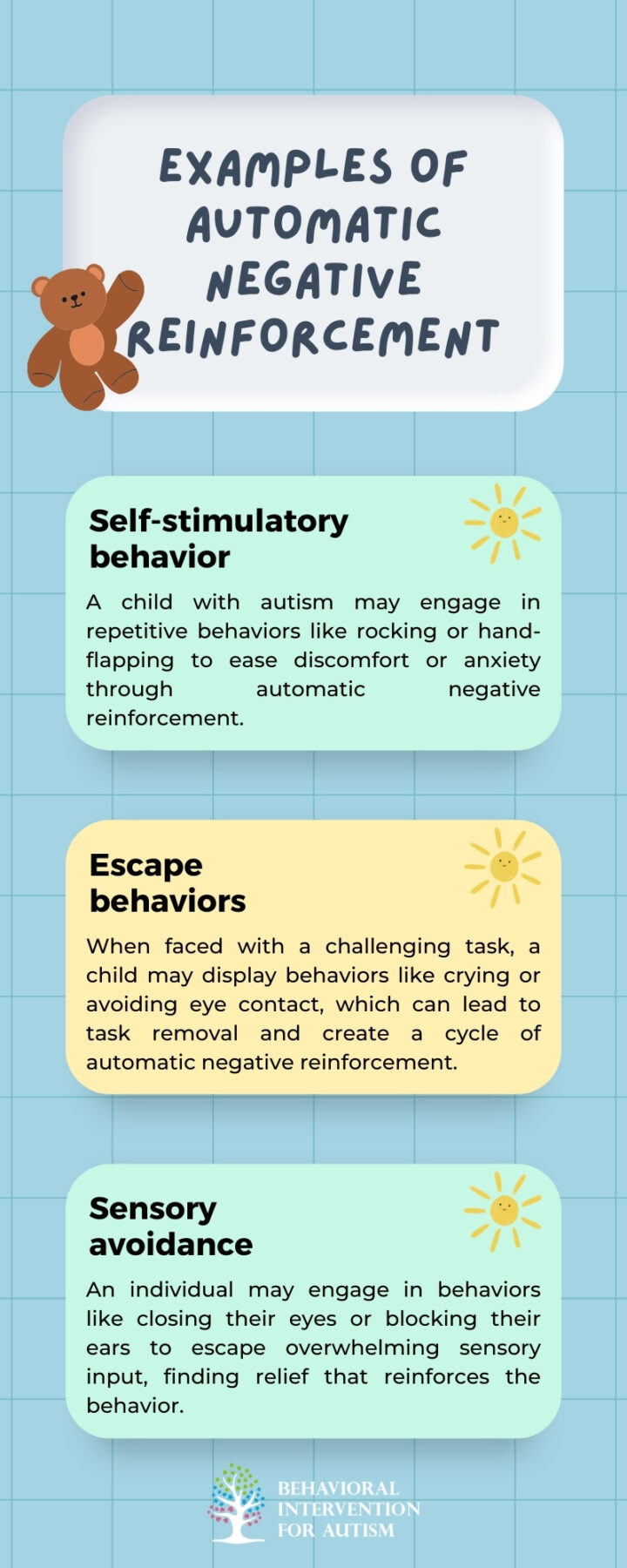
Table of Contents
In Applied Behavior Analysis (ABA) therapy, the concepts of reinforcement play a crucial role in shaping behaviors. Reinforcement can be classified into two categories: positive and negative. While many are familiar with positive reinforcement, automatic negative reinforcement is a lesser-known, yet vital, principle that often plays a role in various behavioral interventions.
Automatic negative reinforcement happens when a behavior is reinforced by the elimination or prevention of an unpleasant stimulus. Unlike social negative reinforcement, where the reinforcement involves the intervention of another individual (such as a therapist), automatic negative reinforcement occurs independently of social interaction. This form of reinforcement is crucial for understanding how certain behaviors can be self-maintained, and it helps clinicians devise effective strategies for behavior modification.
In this article, we will delve into the intricacies of automatic negative reinforcement, including how it works, its role in ABA therapy, and its significance in shaping behavioral patterns in individuals with autism spectrum disorder (ASD).
Understanding Reinforcement in ABA
At its core, reinforcement is any stimulus that, when presented or removed, increases the likelihood of a behavior being repeated. ABA therapy utilizes reinforcement to teach new behaviors, reduce maladaptive behaviors, and promote social and functional skills.
There are two main types of reinforcement:
- Positive Reinforcement: This occurs when a behavior is followed by the presentation of a stimulus, which increases the likelihood of that behavior being repeated. For example, providing a reward when a child uses appropriate language.
- Negative Reinforcement: The removal of an aversive stimulus after a behavior occurs leads to a higher probability of that behavior being repeated. In ABA, we focus on two kinds of negative reinforcement: social and automatic.
Social vs. Automatic Negative Reinforcement
While social negative reinforcement involves a person or environment responding to the behavior (e.g., a therapist removes a demand when a child engages in a challenging behavior), automatic negative reinforcement is different in that the reinforcement happens naturally and automatically, without any social interaction. In automatic negative reinforcement, the aversive stimulus is removed or avoided as a result of the individual’s behavior, leading to a reduction in discomfort or unpleasant experiences.
How Automatic Negative Reinforcement Works
In automatic negative reinforcement, a behavior is performed to eliminate or avoid a negative stimulus. Over time, the individual learns that the behavior leads to relief, and therefore, the behavior is reinforced.
For example, imagine a person who has a headache. They might engage in a behavior such as lying down in a quiet room or turning off a bright light, which provides relief from the headache. The behavior of avoiding the painful stimulus (the headache) is automatically reinforced because it results in the removal of discomfort.
Examples of Automatic Negative Reinforcement
In the context of ABA therapy, there are numerous examples of automatic negative reinforcement in action. Here are a few:

The Role of Automatic Negative Reinforcement in ABA Therapy
Automatic negative reinforcement plays an essential role in ABA therapy, particularly when working with individuals who engage in behaviors that seem to be self-reinforcing. One of the main goals of ABA therapy is to identify the underlying function of behaviors. An automatically reinforced behavior occurs when the individual uses the behavior to escape an unpleasant stimulus, such as pain or sensory overload.
For example, a child who rocks back and forth might be doing so to reduce feelings of anxiety or sensory discomfort. Once this behavior is identified as a form of automatic negative reinforcement, the therapist can work to modify the environment, teach alternative coping strategies, and reduce the need for the maladaptive behavior.
Implications for Behavior Modification
Automatic negative reinforcement can make behavior difficult to change since it is self-reinforcing. Standard approaches like positive reinforcement may fail when the behavior is reinforced through the removal of an unwanted stimulus.
ABA therapists may use various techniques to address automatic negative reinforcement, such as:
- Functional communication training (FCT): Teaching the individual to use appropriate forms of communication to express their need for escape or avoidance.
- Sensory integration therapy: Helping the individual regulate sensory stimuli in their environment to minimize the need for avoidance behaviors.
- Environmental modifications: Reducing or eliminating the aversive stimuli that trigger the maladaptive behaviors in the first place.
Understanding the function of automatic negative reinforcement, therapists can create interventions that focus on preventing or replacing these self-reinforcing behaviors with more adaptive coping strategies.
Addressing Automatic Negative Reinforcement: Strategies and Interventions
When automatic negative reinforcement is identified as the function of a behavior, the goal is to find ways to eliminate the need for the behavior while still addressing the underlying issue. Some of the most effective strategies used in ABA therapy include:
- Differential Reinforcement of Alternative Behaviors (DRA): This involves reinforcing a behavior that serves the same purpose as the undesirable behavior but is more appropriate. For instance, a child who engages in hand-flapping to self-soothe might be taught to use deep breathing exercises or another calming activity instead.
- Functional Communication Training (FCT): By teaching individuals how to communicate their needs effectively, FCT replaces problem behaviors with appropriate communication skills. If a child uses escape behaviors to avoid tasks, they might be taught to ask for a break in an appropriate manner.
- Desensitization or Gradual Exposure: For children who engage in automatic negative reinforcement due to sensory sensitivities or anxieties, gradual exposure to the stimulus in a controlled and supportive way can reduce the aversiveness of the stimulus over time.
- Environmental Modifications: Making changes to the physical or sensory environment can also help reduce the aversive stimulus that is driving the behavior. For example, reducing loud noises in a classroom setting might eliminate the need for escape behaviors associated with sound sensitivity.
2 Challenges in Working with Automatic Negative Reinforcement
Automatic negative reinforcement presents several challenges, including the difficulty in identifying self-reinforcing behaviors and their persistence over time. Understanding these obstacles is essential for designing effective interventions. Here are some key difficulties professionals encounter when addressing automatic negative reinforcement.
Difficulty in Identifying Self-Reinforcing Behaviors
One of the biggest challenges when dealing with automatic negative reinforcement is identifying which behaviors are being self-reinforced. Since there is no external reinforcer (like a teacher or parent providing reinforcement), it can be difficult to pinpoint the exact cause of the behavior. Behavioral assessments, such as functional behavior assessments (FBAs), are critical for understanding the function of behaviors and formulating effective interventions.
The Persistence of Self-Reinforcing Behaviors
Automatic negative reinforcement can be highly persistent because the reinforcement is immediate and self-sustaining. This makes it difficult for individuals to change behaviors once they are ingrained. It is important to approach interventions with patience and consistency to help the individual find more effective coping strategies.
Automatic negative reinforcement plays a critical role in shaping behavior in ABA therapy. By understanding how behaviors are reinforced through the escape or avoidance of aversive stimuli, therapists can design more effective interventions to address maladaptive behaviors. Through strategies like functional communication training, differential reinforcement, and environmental modifications, automatic negative reinforcement can be managed and replaced with more adaptive responses, allowing individuals to thrive and engage in meaningful behavior change.
Incorporating these strategies into ABA therapy helps to create an environment where individuals can learn healthier coping mechanisms, reduce stressors, and improve their overall well-being. Through careful observation, tailored interventions, and consistent support, ABA therapists can help individuals move toward positive behavior change, enhancing their quality of life and social functioning.
Start Your ABA Journey with Us Today
Automatic negative reinforcement plays a significant role in ABA therapy, and we are here to help guide you through the process. With our experienced team, we create personalized interventions that help reduce negative behaviors while encouraging more positive responses. If you’re seeking professional support for your loved one, reach out to us today. We specialize in ABA therapy in Florida, offering compassionate, expert care. Behavioral Intervention For Autism takes pride in delivering tailored solutions that make a difference. Let us partner with you to improve your child’s progress and quality of life. Contact us now to begin the journey!
- 9 Common Obsessions of Children With Autism You Should Know - February 25, 2025
- What is Neurodiversity? A Guide to Embracing Differences - February 25, 2025
- Understanding Hyperfocus in Autism: What It Means and Why It Happens - February 25, 2025

